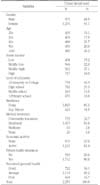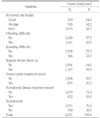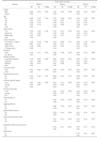Abstract
Objectives
The purpose of this study was to investigate the reasons for unmet dental needs in Korea and to find ways to improve dental care accessibility by using data from the 6th National Health and Nutrition Survey.
Methods
This study was performed using data collected from the 6th National Health and Nutrition Examination Survey (KNHANES). A total of 2,251 subjects were selected for the study. Statistical analysis was performed using SPSS 21.0 on data files obtained according to complex sampling design, and a significance level of 0.05 was used. General characteristics of the subjects, oral health status, and unmet dental needs were examined for a complex sampling frequency analysis, and the differences in distribution were analyzed using chi-square analysis. Relevant factors were determined using logistic regression analysis.
Results
According to the logistic regression analysis, in Model 1, gender, household income, employment status, and subjective health status were found to be significantly related to unmet dental needs (P<0.05). In Model 2, subjective health status, subjective oral health status, and chewing difficulty were significantly related to unmet dental needs (P<0.001). Model 3 showed a significant relationship between subjective health status, subjective oral health status, chewing difficulty, periodontal disease, and unmet dental needs (P<0.001).
Conclusions
We conclude that the reasons for the unmet dental needs in Korea are socioeconomic status, general health status, and oral health status. In the future, economic barriers to obtaining dental care need to be overcome through improvements in health insurance policies and systems and diversification of private insurance. Oral health should be improved through oral health education, which can create awareness and provide motivation for maintaining oral health.
Figures and Tables
References
1. Gerritsen AE, Allen PF, Witter DJ, Bronkhorst EM, Creugers NH. Tooth loss and oral health-related quality of life: a systematic review and meta-analysis. Health Qual Life Outcomes. 2010; 8:126.

2. Slade GD, Strauss RP, Atchison KA, Kressin NR, Locker D, Reisine ST. Conference summary: assessing oral health outcomes-measuring health status and quality of life. Community Dent Health. 1998; 15(1):3–7.
3. Petersen PE, Bourgeois D, Ogawa H, Estupinan-Day S, Ndiaye C. The global burden of oral diseases and risks to oral health. Bull World Health Organ. 2005; 83(9):661–669.
4. Ministry of Health & Welfare. Health Plan 2020. Seoul: Ministry of Health & Welfare;2011. p. 320–352.
5. Korea Centers for Disease Control and Prevention. 2008 National health statistics. Korea National Health and Nutrition Examination Survey IV 2nd year (2008). Seoul: Korea Centers for Disease Control and Prevention;2009. p. 58–59. p. 277–283.
6. Baldani MH, Mendes YBE, de Campos Lawder JA, de Lara API, da Silva Rodrigues MMA, Antunes JLF. Inequalities in dental services utilization among Brazilian low-income children: the role of individual determinants. J Public Health Dent. 2011; 71(1):46–53.

7. Jeon JE, Chung WG, Kim NH. Determinants for dental service utilization among Koreans. J Korean Acad Oral Health. 2011; 35:441–449.
8. Moon SE, Song AH. Factors affecting unmet dental care needs of Korean: The 6th Korean national health and nutritional examination survey. J Korean Soc Dent Hyg. 2016; 16(5):769–774.

9. Kullgren JT, McLaughlin CG, Mitra N, Armstrong K. Non-financial barriers and access to care for U.S adults. Health Serv Res. 2012; 47:462–485.

10. Kullgren JT, McLaughlin CG. Beyond afford ability: The impact of non-financial barriers on access for uninsured adults in three diverse communities. J Community Health. 2010; 35:240–248.

11. Shin HS, Kim HD. Income related inequality of dental care utilization in Korea. Health Soc Welf Rev. 2006; 26:69–93.
12. Park HJ, Lee JH. The effect of socioeconomic status, oral health consciousness and behaviors on the periodontal health disparities among Korean adults. Korean J Health Educ Promot. 2010; 27:61–69.
13. The Sixth Korea National Health and Nutrition Examination Survey (KNHANES VI-2). Seoul: Ministry of Health & Welfare;2015. p. 1–334.
14. Lee HS. Factors affecting dental utilization of women: An application of the Andersen-Newman model. J Korean Acad Dent Health. 1994; 18:513–525.
15. Kim HY, Lee SW, Cho SI, Patton LL, Ku Y. Associations between missing teeth with unmet needs and socioeconomic status among South Korean dentate government employees. J Public Health Dent. 2007; 67:174–178.

16. Jeon JE, Chung WG, Kim NH. The reason of unmet dental need related socioeconomic status in Korea: Using the 4th Korea National Health and Nutritional Examination Survey. J Korean Acad Oral Health. 2012; 36:73–81.
17. Weich S, Lewis G, Jenkins S. Income inequality and self rated health in Britain. J Epidemiol Community Health. 2002; 56(6):436–441.





 PDF
PDF ePub
ePub Citation
Citation Print
Print







 XML Download
XML Download